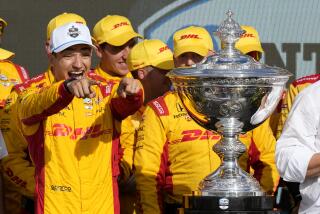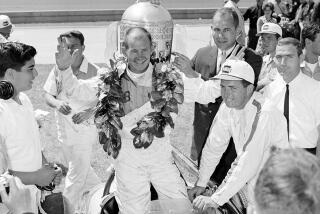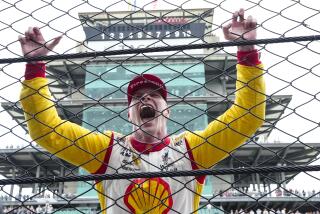The Last Time for Foyt : Race: He’s not the favorite this year, but, at 56, the four-time winner is front and center.
INDIANAPOLIS — Sometime this morning, a thick-set man in his 50s, wearing a black cap and a black driving suit will come swaggering out of Gasoline Alley, and those of the 400,000 on hand who catch a glimpse of him will let loose a cheer that will rock the foundations of Indianapolis Motor Speedway.
As he ambles along pit road with that rolling gait so familiar to racing fans--now accentuated by a slight limp--the crowd in the grandstands and the infield bleachers will rise in a tribute--perhaps a final one--to motor racing’s grandest figure.
A.J. Foyt, 56, winner of four Indianapolis 500s, is not the favorite in today’s 75th running of the event, but he is certainly its centerpiece. This is his 34th consecutive 500, and he says it will be his last as a driver.
Foyt will start on the front row in his black No. 14 Lola, powered by a turbocharged Chevy V8. On either side of him will be Rick Mears, a three-time winner starting from the pole for a record sixth time, and Mario Andretti, the 1969 winner and the only driver who might rival Foyt in popularity.
It is a front row of legends in perhaps the most intriguing field of 33 drivers in the race’s long history. Also, the most competitive.
The highlights at Indy on a day when the weather forecast calls for a 70% chance of rain in the morning and 40% in the afternoon:
--There are four Andrettis in the race: Mario, elder son Michael, nephew John and youngest son Jeff. They are spread out, one each among the first four rows. It is the first time four drivers from the same family have qualified for the 500.
--Willy T. Ribbs, the first black driver in the 500. Ribbs, after struggling for 15 years on the fringes of big-league racing, will start 29th after a dramatic final-day qualification.
--Hiro Matsushita, the first Japanese driver to compete at Indy. He is one of five rookies in the race, joining Ribbs, Jeff Andretti, Mike Groff and Buddy Lazier in a battle for rookie-of-the-race honors.
--The fifth row of Gary Bettenhausen, defending champion Arie Luyendyk and Emerson Fittipaldi, is more than a mile per hour faster (223.804 m.p.h. to 222.781 m.p.h.) than the front row. All three passed up opportunities to run for the pole on the first qualifying day when they were confused by changing weather patterns. Bettenhausen, in his 19th 500, ran the fastest four laps in qualifying at 224.468 m.p.h., but Mears has the pole with his first-day speed of 224.113 m.p.h. The fastest qualifier has been back in the field several occasions, but never has an entire row been faster than the three up front.
--And, of course, Foyt, with his remarkable 34 consecutive starts. The nearest drivers to him are Mario Andretti with 26, Al Unser with 25 and Johnny Rutherford with 24.
Eight former winners, from 14 races, give the field a sense of stability. They are Foyt, 1961-64-67-77; Andretti, 1969; Gordon Johncock, 1973-82; Mears, 1978-84-88; Danny Sullivan, 1985; Bobby Rahal, 1986; Fittipaldi, 1989, and Luyendyk, 1990.
Three polls taken of race reporters and broadcasters at different times led to four drivers sharing the favorite’s role.
Al Unser Jr., the defending PPG Cup national champion and run-ner-up two years ago to Fittipaldi, was the choice of the the Unocal 76 Racing panel; Michael Andretti, who hopes to leave Indy cars next year for the glamorous world of Formula One, was the top choice in a USA Today poll and in an Associated Press poll Mears was a one-vote choice over Rahal, who has finished second in all three Indy car races this year.
“I would say there are at least 10 drivers you could make a solid case for as a potential winner Sunday,” Luyendyk said.
Foyt, despite his front-row speed of 222.443 m.p.h., is probably not one of the 10 in Luyendyk’s thinking. After all, he has not won the 500 since 1977 and has not won an Indy car race of any kind since the Pocono 500 in 1981.
The miracle is that he is here after his feet and legs were battered in a head-on crash into a dirt embankment last September in a race at Elkhart Lake, Wis. Foyt already had announced 1991 would be his final season, and friends urged him to quit after the accident.
“I hurt, I’ll tell you, I hurt like I never hurt before, but never for a minute did I feel like not coming back,” Foyt said. “My goal was to get back here and race, and that’s the reason we worked so hard. I was gonna make it one way or another unless something radical happened. That was the only thing that could’ve kept me out of the race.”
There was speculation along pit row when practice started on May 4 that he might hurt so badly, he wouldn’t even be able to qualify. He passed on an opportunity to race into condition a few weeks earlier at Phoenix.
But when time trials opened two weeks ago, Foyt drew the first qualifying spot and ended doubts when his first lap exceeded 221 m.p.h. and each succeeding lap was faster. Now there are doubters who don’t think he can go 500 miles.
“If I didn’t think I could go the distance, I wouldn’t have qualified the car,” he said. “I’m gonna run just as hard as the car’ll let me run.
“If there’s anything special I’ve got to do, it’s being a little slower and more careful getting in and out of the car so I don’t hit my shins and knees.”
Foyt’s injuries included a broken left knee, dislocated left heel, crushed right heel and severe swelling in both feet.
Dr. Terry Trammell of the CART safety team and an orthopedic surgeon who worked on Foyt, was one of the first to reach the accident scene.
“After dogpaddling out some of the dirt, I found his one foot, but I couldn’t figure out how his knee could be where it was and still be connected,” Trammell said. “Once we got it all dug out and could see the way things were laying, it was quite a relief.”
At first, there was serious consideration given to amputating Foyt’s left leg.
“When they were talking amputation that night, that gave me a pretty good scare,” Foyt said. “I just couldn’t see them having to cut one of my legs off. I don’t know how I could’ve accepted that.”
Circulation in the leg was restored, ending threats of amputation, and after he was released from the hospital, Foyt began daily physical therapy with Steve Watterson, rehabilitation coach for the Houston Oilers.
Now he is here, on the front row, limping slightly and still hurting, ready to give Indianapolis 500 fans one last thrill at seeing him emerge from the garage area and head for his car, orange helmet in hand.
Said Tony George, president of the Speedway and grandson of the late Tony Hulman, who rescued the facility in 1947: “As long as I’ve been at the 500, and naturally that’s been just about all my life, I’ve never heard anyone cheered, even after winning the race, the way the fans cheer A.J. every time he shows his face on race day.”
* LINEUP: C3
THE INDY 500 Today is the 75th running of the Indianapolis 500 at Indianapolis Motor Speedway. It has been held every year since 1911 with the exception of the war years of 1917-18 and 1942-45. The Speedway The Speedway opened Aug. 19, 1909 with a surface of crushed stone and tar for three days of racing, but accidents in the initial event pursuaded management that a new surface was needed. By December, the track had been covered by 3.2 million paving bricks and racing was resumed the next spring. The inaugural Indianapolis 500, at what became known as “the Brickyard” because of the racing surface, took place May 30, 1911. Parts of the track were resurfaced with asphalt in 1937, and the entire track was resurfaced with asphalt in 1976 and again in 1988. The First Indy Ray Harroun, 32, came out of retirement to win the first 500. An engineer with the Marmon car company in Indianapolis, he designed the innovative Marmon Wasp, a lightweight single-seater with a pointed tail and a small stabilizer. His was the only car in the field without a riding mechanic who could watch for cars approaching from the rear, and because of that, the other drivers considered him a safety risk. He answered by installing a rear-view mirror, believed to be the first time one appeared on an automobile of any kind. He finished in 6 hours 42 minutes 8 seconds and averaged 74.602 m.p.h, but the car was not challenged in Indy competition again. The following year, single-seaters were banned. 1990 Indy Emerson Fittipaldi set the tone by running the first four laps in a sizzling 213 m.p.h., and the pace didn’t back off much from there. Eventually, as Fittipaldi had to pit for tire changes, Arie Luyendyk of the Netherlands took over. He finished first with an average speed of 185.984 m.p.h., more than 15 m.p.h. faster than the previous 500-mile record of 170.722 set by Bobby Rahal in 1986. Luyendyk’s first Indy car victory took 2 hours 41 minutes 18 seconds.
More to Read
Go beyond the scoreboard
Get the latest on L.A.'s teams in the daily Sports Report newsletter.
You may occasionally receive promotional content from the Los Angeles Times.










